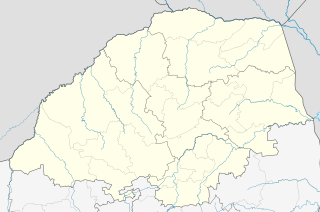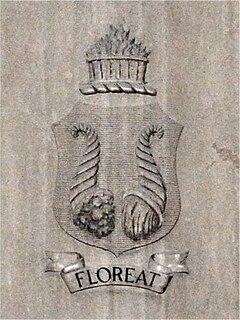
Polokwane, also known by its former name, Pietersburg, is a city and the capital of the Limpopo Province of South Africa. It is South Africa's largest urban centre north of Gauteng. Polokwane was one of the host cities of the official tournament of the 2010 FIFA World Cup.

Uitenhage is a South African town in the Eastern Cape Province. It is well known for the Volkswagen factory located there, which is the biggest car factory on the African continent. Along with the city of Port Elizabeth and the small town of Despatch, it forms the Nelson Mandela Metropolitan Municipality.

Harrismith is a large town in the Free State province of South Africa. It was named for Sir Harry Smith, a 19th-century British governor and high commissioner of the Cape Colony. It is situated by the Wilge River, alongside the N3 highway, about midway between Johannesburg, about 300 km to the north-west, and Durban to the southeast. The town is located at the junction of the N5 highway, which continues westward towards the provincial capital Bloemfontein, some 340 km to the south-west. This important crossroads in South Africa's land trade routes is surrounded by mesas and buttes. It is located at the base of one of these called Platberg.

The lozenge in heraldry is a diamond-shaped charge, usually somewhat narrower than it is tall. It is to be distinguished in modern heraldry from the fusil, which is like the lozenge but narrower, though the distinction has not always been as fine and is not always observed even today. A mascle is a voided lozenge—that is, a lozenge with a lozenge-shaped hole in the middle—and the rarer rustre is a lozenge containing a circular hole in the centre. A field covered in a pattern of lozenges is described as lozengy; similar fields of mascles are masculy, and fusils, fusily. In civic heraldry, a lozenge sable is often used in coal-mining communities to represent a lump of coal.

Kraaifontein is a town in the Western Cape province of South Africa and a northern suburb of Cape Town. The name originated from large number of crows that nest in the region.

Leucadendron argenteum is an endangered plant species in the family Proteaceae, which is endemic to a small area of the Cape Peninsula, South Africa. Most grow in and around the city of Cape Town, but outlying populations exist near Somerset West (Silwerboomkloof), Paarl and Stellenbosch. It is a protected tree in South Africa.

Gordon's Bay is a harbour town in the Western Cape province of South Africa. It is included in the City of Cape Town metropolitan municipality as a suburb of the Helderberg region. It is situated on the shores of Gordon's Bay in the northeastern corner of False Bay about 58 km from Cape Town to the south of the N2 national road and is named after Robert Jacob Gordon (1743–1795), the Dutch explorer of Scottish descent.

Milnerton is a seaside suburb on Table Bay and is located directly north of Cape Town in South Africa. It is located 11 kilometres to the north of the city's centre.

The cross moline is a Christian cross, constituting a kind of heraldic cross.

South African heraldry dates back to the 1650s, inheriting European heraldic traditions. Arms are borne by individuals, official bodies, local authorities, military units, and by a wide variety of organisations. South Africa has had its own heraldic authority since 1963, to provide armigers with legal protection, and to promote high standards of armorial practice.

The wolf has been widely used in many forms in heraldry during the Middle Ages. Though commonly reviled as a livestock predator and man-eater, the wolf was also considered a noble and courageous animal, and frequently appeared on the arms and crests of numerous noble families. It typically symbolised the rewards of perseverance in long sieges or hard industry.

Frederick Gordon Brownell was a South African herald, vexillologist, and genealogist.

The Charlotte Maxeke Johannesburg Academic Hospital is an accredited general hospital in Parktown, Johannesburg, Gauteng, South Africa.
Kalafong Provincial Tertiary Hospital is a public hospital in Pretoria, Gauteng, South Africa. The hospital is situated on the western outskirts of Pretoria in the suburb of Atteridgeville. The University of Pretoria uses the hospital as a training institution for the Faculty of Health Sciences.
Livingstone Hospital is a large Provincial government-funded hospital situated in Korsten, Port Elizabeth in South Africa. It is a tertiary hospital and forms part of the Port Elizabeth Hospital Complex.
Fort England Psychiatric Hospital is a government funded psychiatric hospital and drug rehabilitation centre for the Makana Local Municipality area in Grahamstown, Eastern Cape in South Africa.
St Vincent Whitshed Erskine, Surveyor General of South Africa, was an early explorer in Gazaland and was the first European to travel down the length of the Limpopo river to its mouth.

Tygerberg Hospital is a tertiary hospital located in Parow, Cape Town, South Africa. The hospital was officially opened in 1976 and is the largest hospital in the Western Cape and the second largest hospital in South Africa, with the capacity for 1899 beds. It acts as a teaching hospital in conjunction with the Stellenbosch University's Health Science Faculty. To become a patient at Tygerberg, a person must be referred by a primary or secondary health care facility. Over 3.6 million people receive health care from Tygerberg, either directly or via its secondary hospitals, such as Paarl and Worcester Hospital. During the normal working day there are about 10,000 people on hospital grounds.





















